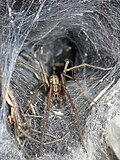Disambiguation gallery
- Yellow sac spider , Chiracanthium inclusum, a common house spider worldwide
- Black house spider, Badumna insignis, an Australian spider also found in New Zealand
- American house spider, Parasteatoda tepidariorum, a cobweb spider
- Brown house spider, Steatoda grossa, a spider with cosmopolitan distribution
- Southern house spider, Kukulcania hibernalis
- Hobo spider, Tegenaria agrestis (sometimes called the aggressive house spider)
- Domestic house spider, Tegenaria domestica
- Cellar spiders, of the family Pholcidae
- Giant house spider, Eratigena atrica (formerly Tegenaria gigantea)
- Geometric house spider, Latrodectus geometricus
- Tiny house spider, Oonops domesticus










